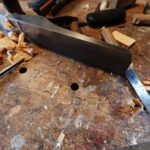Introduction
Woodwork cleaning is an important part of taking care of interior and exterior wood surfaces. Not only does it improve the look and feel of the wood, but it also helps protect the material from water damage and other environmental stresses that can weaken it over time. Plus, since proper maintenance requires fewer repairs down the road, proper woodwork cleaning will actually save you money in the long run. So what products should you use when cleaning your wooden surfaces? Let’s take a look at some of the most common options.
One of the most effective methods for cleaning woodwork is to use a gentle soap, such as Murphy’s Oil Soap or Castile soap, diluted in warm water. Be sure to test it on a small section beforehand to make sure it won’t stain the wood or leave any residue behind. If necessary, you can use a soft cloth or brush to scrub away dirt, grime, and mildew from moldy spots. Just be sure not to apply too much pressure as this could damage the grain or paint finish on delicate pieces. You may need to use sandpaper on tougher stains, but this should always be done lightly with fine-grade sandpaper or steel wool.
For tougher jobs like dealing with grease and oil spills — usually found around kitchen door frames — you’ll want to invest in cleaner specifically designed for these types of problems such as Formula 409 All Purpose Cleaner. Spray it directly onto the affected area and let it sit for several minutes before wiping off with a wet cloth or sponge. To clean dirty marks made by metal items dragging across finishes — commonly found around doorknobs and other metal fixtures — try mineral spirits applied with a piece of clean rag cloth instead (avoid using chemical-based products). Finally, for polishing wooden furniture and antiques keep beeswax-based products on hand as they help nourish wood without altering its color; alternatively you can use a slightly damp cheesecloth rubbing with nonabrasive furniture waxes/creams.( i .e Briwax )
Different Types of Wood and Their Unique Cleaning Needs
Most woodwork is made from one of three main types of wood: softwoods, such as pine; hardwoods like oak and mahogany; and manufactured woods, such as particle board and plywood. Each wood type has its own cleaning needs, so it’s important to find the right product for the job.
Softwoods: Softwoods are some of the most delicate woods and require special care when cleaning. For these woods, it’s best to use a mild soap or detergent combined with warm water to clean away dirt and grime. For tough stains or spots, you may need a soft-bristled brush and some lightly dampened steel wool (be sure not to scrub too forcefully).
Hardwoods: Since hardwood surfaces generally feature a finish like varnish or lacquer, cleaning usually involves just wiping down with a damp cloth or mild soap diluted with water. If tougher spots are present, you can use a quality furniture cleaner designed specifically for hardwoods. A gentle polish can help enhance the natural sheen of hardwoods without causing any damage.
Manufactured Woods: Manufactured woods can typically withstand stronger cleansers than those used on soft- and hardwoods — even that annoying sticky kitchen countertop mess can be wiped away with an all-purpose cleaner if you’re careful! If you do use a store-bought cleaner on plywood, be sure to dilute it as directed by manufacturer instructions before using it on your cabinetry or other surfaces.
Benefits of Professional Wood Cleaning Services
Using professional wood cleaning services can maximize the lifespan and look of your woodwork. Professional wood cleaning utilizes specialized techniques, equipment, and solutions to help preserve the beauty and structural integrity of your hardwood furniture or fixtures. Professional cleaning also helps protect against common issues such as water damage, cracking, and warping that frequently occur when cleaning with over the counter products or natural materials. Many services often include sanding, buffering, staining, waxing, polishing, tung and linseed oils, sealers and varnishes treatments to enhance the finish of the woodwork. Professionals are also able to treat wooden surfaces for mold prevention and eradication with specialized solutions. Wood furniture is also very susceptible to sticky buildup from dust and other residue in environments with low indoor air quality. Professional services can reduce buildup by utilizing powerful vacuums designed specifically for use on hardwood surfaces followed by an application of protective polish recommended by the manufacturer if necessary. With regular wood cleaning service appointment intervals ranging from every 6 months-2 years depending on environmental conditions and exposure levels it is important to maintain a consistent schedule for optimum results.
A Look at Commercial Wood Cleaning Products
When it comes to cleaning and protecting your woodwork, there is a variety of commercial wood cleaning products on the market. These products range from liquid polishes to aerosols that are specifically tailored to different types of timber. Depending on the type of wood you have in your home, you may need different types of products. For example, if you have hardwood floors such as walnut or teak, you should use a specially formulated product designed for these woods. Other common wood cleaning products include conditioners, which help prevent marks and scratches caused by movement, or furniture wax which can help keep your furniture looking new and polished for years to come. Additionally, commercial wood cleaners come in many price ranges for different budgets. Regardless of the type of wood in your home, you can find a cleaning product suited specifically for it.
Alternative DIY Cleaning Solutions for Woodwork
When it comes to cleaning your woodwork, it is important to choose the right solution. The wrong cleaner can damage the finish of your woodwork and furniture. Fortunately, there are several natural DIY solutions that you can use to clean your woodwork safely and effectively.
One of the best options for cleaning woodwork is a combination of white vinegar and vegetable oil. Mix equal parts of both ingredients together in a bowl and use a soft, clean cloth to apply the solution. Rub gently in a circular motion for a few minutes before wiping away any excess with another damp cloth. This all-natural mixture is perfect for removing dirt, grime and grease from wooden surfaces without leaving streaks or damaging the finish of the wood.
Another effective way to clean woodwork is with lemon juice and olive oil. Mix together two parts olive oil with one part lemon juice in a bowl and apply directly onto the surface with a soft cloth. Leave this homemade solution on for 15-20 minutes before buffing with another clean cloth and wiping excess oil away with yet another damp cloth. This method helps remove deep-set stains without causing any harm or discoloration to your woodwork’s finish or color.
Finally, you can also use soapy water to clean your woodwork’s surfaces as long as you use non-abrasive cleaning products such as dish soap or laundry detergent mixed into lukewarm water. Gently scrub surfaces of dirt and dust but be sure not saturate too much otherwise you may risk making warping worse over time due to possible water damage!
Safety Tips to Keep in Mind When Cleaning Woodwork
When cleaning woodwork, it is important to take safety precautions to ensure a safe and successful experience. Some tips to keep in mind are:
• Always wear protective gear such as gloves and a dust mask when cleaning to protect your skin and respiratory system from hazardous materials you may come into contact with.
• Make sure the work area of your woodwork is well ventilated by opening windows or using an exhaust fan for when using chemical cleaners or abrasive tools.
• Make sure all electrical surfaces are dry before applying any liquids or sprays that you’ll be using for cleaning.
• Before starting a project, take time to inspect the wood on which you will be working for any existing damage as this could reduce the life of the wooden piece if not handled properly.
• When wiping off residue from wood cleaner, make sure to use clean rags that are soft enough not to scratch or damage the surface of the woodwork.
Tips and Tricks for Long-Term Maintenance of Woodwork
For an effective long-term maintenance of woodwork, you need to regularly clean and protect it. Here are some tips and tricks for effective cleaning and protection of your woodwork:
• Clean your wood with a gentle cleaner like white vinegar and warm water or mild liquid dish soap. Rinse the affected areas with clear water and thoroughly dry before treating the surface with a polisher or protector.
• To remove grease marks, you can use products specifically designed for this purpose, but rubbing alcohol also works. A dab of cooking oil on a cloth can also help to remove greasy stains.
• If you have stained surfaces, avoid abrasive cleaners as they will scratch the finish. Instead use an oil soap-based cleaner such as Murphy’s Oil Soap or Castile Soap.
• To restore furniture’s natural colour and sheen, first use a paste wax that is safe for wood finishes then apply a hard wax such as beeswax or carnauba wax following the directions on the product label. For deep scratches, try adding some finishing putty which will fill them in nicely.
• Regular dusting keeps away dust mites and dust buildup which makes it harder to clean over time. Keeping this in mind also helps to maintain its look longer by preventing dirt build up and scratches in the surface coating.
• Try using polishes only occasionally as they contain oil or silicone that may cause a film to accumulate over time if used too often. This will dull wood finishes and make them harder to keep clean in the future.
Common Mistakes to Avoid When Cleaning Woodwork
When cleaning woodwork, it is important to use the correct products and techniques. Avoid using overly harsh or corrosive detergents, soaps, and abrasives on wood surfaces as this can leave unsightly marks or permanent damage. Furthermore, the type of cleaner matches the type of finish on the wood surface. Generally, you want a mild soap and water solution for good but do not soak the wood. Instead use a clean dry cloth to apply and then dry as soon as possible with another cloth. When scrubbing stains, use a circular motion to keep from wearing down any part of the finish that may be present. Oil-based cleaners should only be used on unfinished surfaces while wax-based cleaners are more suitable for finished surfaces. Most importantly, always test the cleaning product in an inconspicuous place before applying it over the entire area, just to make sure it is suitable for your wooden surface.
Conclusion
A good cleaning routine will ensure that your woodwork looks great and last a long time. There are a few basic items you should have on hand to keep your wood surfaces clean and protected. For the initial cleaning, use a mild all-purpose cleaner, like dish soap diluted in water. This will help prepare and remove dust, dirt, oils, fingerprints, or smudges from woodwork without damaging the finish. For tougher areas you can use an oil-based hardwood cleaner or mild abrasive cleaner (if recommended by the manufacturer). After wiping away any dirt and grime with a damp cloth, it is important to dry the surface with a separate clean cloth. For routine maintenance, you can use high quality oil-based polishes or waxes specifically designed for wooden furniture and cabinetry. Before applying any polish or wax make sure to test it in an out of sight area first! Finally, avoid using household cleaners that contain lemon or citrus as these can damage the finish of your woodwork. With regular care, your wood surfaces will stay looking beautiful for years to come!

Hi everyone! I’m a woodworker and blogger, and this is my woodworking blog. In my blog, I share tips and tricks for woodworkers of all skill levels, as well as project ideas that you can try yourself.





